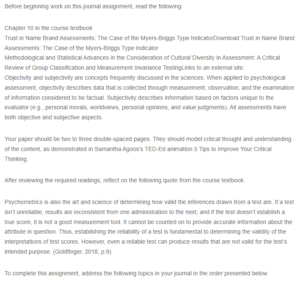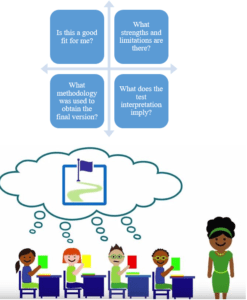Ethics, Subjectivity, and the Art of Assessment
The Wechsler Intelligence Scale for Children-V (WISC-V) is one of the psychological tests I came across during my study. This is an intelligence test that was authored by David Wechsler and published by Pearson in 2014. The test measures the intellectual ability of children between the ages of 6 and 16 and 11 months, together with five cognitive domains that are likely to affect performance. These domains include fluid reasoning, working memory, processing speed indices, verbal comprehension, and visual and spatial abilities (Kumar et al., 2021). I have a great interest in the intellectual abilities and behaviours of children, and this test is capable of providing interpretive information that can aid in diagnosing executive function issues, ADHD, non-verbal difficulties, as well as reading and language disorders (Wechsler, 2021). Through this test, children can obtain the necessary treatment to aid in their general well-being.
Ethics
Whenever psychological tests are administered to diverse populations, Han et al. (2019) claim that the assumption made is that the test represents a similar level of the fundamental construct across various groups and forecasts a similar outcome score. Across various cultures, cognitive abilities contributing to intelligence manifest differently as this is mainly determined by the cultural or contextual variables significant for that particular culture (van de Vijver et al., 2019). However, by considering various cognitive processes, researchers demonstrate that a universal factor intelligence construct arises even cross-culturally with very few differences. The WISC-V test considers these cognitive processes, making it applicable and valid across various cultures in Asia, Europe, and North America (van de Vijver et al., 2019). When the WISC-V test was developed, the developers strived to reduce the impact of cultural bias following international adaptation. For instance, verbal questions and vocabulary words that were considered by local reviewers to be less or more commonly known in particular nations, hence altering the difficulty level, were replaced early in the process (van de Vijver et al., 2019). The final version of the WISC-V test was developed, and the results and development methodology were documented to suit different regions. Some nations were open to a more formal assessment by the local testing authorities. Generally, test bias is less among Western countries and more, though insignificant, in non-Western countries. Goldfinger (2018) insists that no perfect test is capable of attaining 100 per cent validity and reliability. Still, improvements are constantly made to ensure test improvement to lessen issues of biasedness.
Subjectivity
My understanding of psychological assessment has greatly improved. I understand the importance of using tests with strong psychometric support, implying well-documented validity and reliability as defined by Goldfinger (2018). I am confident that I cannot be easily swayed by marketing and advertising strategies as I have gained the right skills to assess test validity and reliability. For instance, the Myers-Briggs Type Indicator has been greatly praised and used as an employee assessment. Yet, most scholars are quite critical of the reliability and validity of the assessment (Lake et al., 2019). This implies that the popularity of a test might be misleading, and therefore, a personal evaluation will be important. Besides researching online to find scholarly articles that have been written in regard to the validity and reliability of a test, I can conduct my own research and make use of such models as the classical test theory to test for the reliability of the test.
The Art of Assessment
In the photo above, it can be noted that there are students with varying skin colours, implying different races and cultures as defined by society. When I consider tests or assessments, I am eager to learn if the test fits me. We have learned that some tests are highly prone to bias. This means that if the test was specifically meant for individuals from a certain culture, it might fail to provide appropriate results for individuals outside of that culture. As a result, I believe in the importance of finding out how well a test fits me. I would also consider finding out the methodology used before the final version of the test and the strengths and limitations associated with the test. The meaning of the test results would also be important. By assessing these factors, I will be able to find the best test for me, considering the psychometric support of the tests as evidenced by the test’s reliability and validity.
Conclusion
Generally, psychological assessments will always undergo changes to incorporate the changes in society and individuals. Some tests that were used 100 years ago might not be applicable today due to the changes that have occurred among individuals in society today. It is important to ensure that a test possesses strong psychometric support, as this is the only way accurate data can be obtained to facilitate better decision-making. Furthermore, it is essential to make use of appropriate tests to lower instances of test and evaluator biases and ensure test validity across different cultures.
References
Goldfinger, K. B. (2018). Psychological testing in everyday life: History, science, and practice. SAGE Publications.
Han, K., Colarelli, S. M., & Weed, N. C. (2019). Methodological and statistical advances in considering cultural diversity in assessment: A critical review of group classification and measurement invariance testing. Psychological Assessment, 31(12), 1-64.
Kumar, S., Kartikey, D., & Singh, T. (2021). Intelligence Tests for Different Age Groups and Intellectual Disability: A Brief Overview. Journal of Psychosocial Research, 16(1), 199-209.
Lake, C. J., Carlson, J., Rose, A., & Chlevin-Thiele, C. (2019). Trust in name brand assessments: The case of the Myers-Briggs Type Indicator. The Psychologist-Manager Journal, 22(2), 91-107.
van de Vijver, F. J., Weiss, L. G., Saklofske, D. H., Batty, A., & Prifitera, A. (2019). A cross-cultural analysis of the WISC-V. Academic Press.
Wechsler, D. (2021). Wechsler Intelligence Scale for Children | Fifth Edition. Pearson.
ORDER A PLAGIARISM-FREE PAPER HERE
We’ll write everything from scratch
Question

Ethics, Subjectivity, and the Art of Assessment
Before beginning work on this journal assignment, read the following:
Chapter 10 in the course textbook
Trust in Name Brand Assessments: The Case of the Myers-Briggs Type IndicatorDownload Trust in Name Brand Assessments: The Case of the Myers-Briggs Type Indicator
Methodological and Statistical Advances in the Consideration of Cultural Diversity in Assessment: A Critical Review of Group Classification and Measurement Invariance TestingLinks to an external site.
Objectivity and subjectivity are concepts frequently discussed in the sciences. When applied to psychological assessment, objectivity describes data that is collected through measurement, observation, and the examination of information considered to be factual. Subjectivity describes information based on factors unique to the evaluator (e.g., personal morals, worldviews, personal opinions, and value judgments). All assessments have both objective and subjective aspects.
Your paper should be two to three double-spaced pages. They should model critical thought and understanding of the content, as demonstrated in Samantha Agoos’s TED-Ed animation 5 Tips to Improve Your Critical Thinking.
After reviewing the required readings, reflect on the following quote from the course textbook.
Psychometrics is also the art and science of determining how valid the inferences drawn from a test are. If a test isn’t unreliable, results are inconsistent from one administration to the next, and if the test doesn’t establish a true score, it is not a good measurement tool. It cannot be counted on to provide accurate information about the attribute in question. Thus, establishing the reliability of a test is fundamental to determining the validity of the interpretations of test scores. However, even a reliable test can produce results that are not valid for the test’s intended purpose. (Goldfinger, 2018, p.9)
To complete this assignment, address the following topics in your journal in the order presented below.
Introduction
Identify a psychological test you learned about in this class. Select a test relevant to some aspect of your current or future career journey. It may be a test that was discussed in the course resources or a test you researched for one of the assignments for this course. Briefly describe the test, what it measures, and why you selected it. As this is a journal assignment, your introduction does not need a thesis statement.
Ethics
Discuss ethical and methodological considerations related to cultural diversity using this assessment. For groups representing which types of diversity would this test be most valid? For which diversity groups would you expect test bias or examiner bias to be more likely to impact validity negatively?
Subjectivity
Having completed this class, describe how your understanding of psychological assessment has developed or changed. How susceptible, in general, are you to advertising and marketing strategies, and how might that level of susceptibility make it more likely for you to use a test without fully researching the validity of the test? What resources and skills will enable you to research tests being considered for use fully?
Reminder: An internet search alone does not constitute fully researching a test. Search engines direct sources to users based on algorithms paid advertisements, not science, and confirmation bias often leads users to stop researching once they find an article that agrees with what they already believe or want to believe.
The Art of Assessment
Despite limitations in tests and assessment procedures, they can also be useful in bringing together data and information from multiple sources to understand an individual, group, family, or program better. Reflecting on the quote from the Goldfinger text above and any personal experience with testing and assessment, create an art form to depict what “the art of assessment” means to you. In this section, your creation may be shared in any of the following formats: poem, song lyrics, image, cartoon, storyboard, figure, graphic, or a photograph of a physical item you create. Include a brief description of your creation and explain how it represents “the art of assessment.”
Conclusion
Share any additional reflections you would like to share related to psychological testing and assessment.


